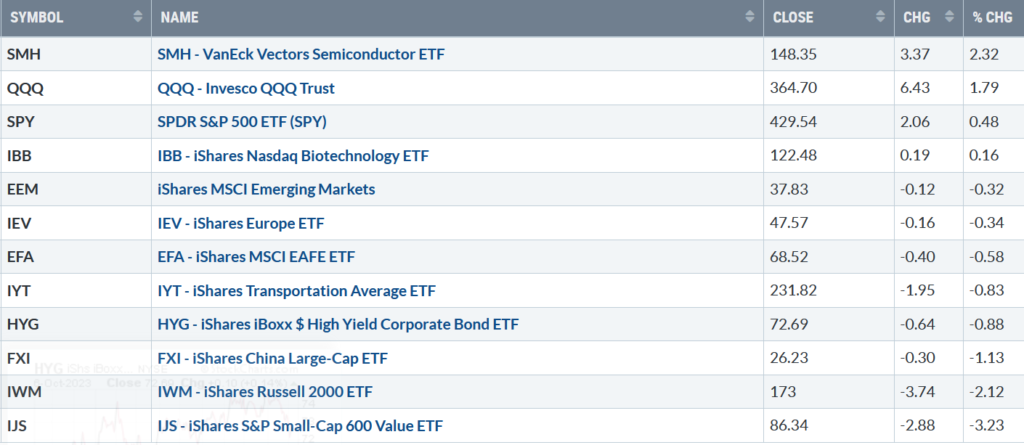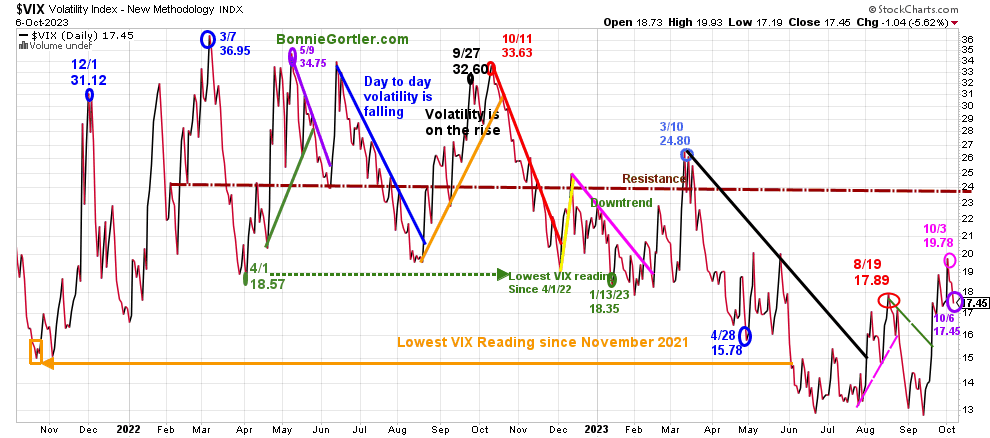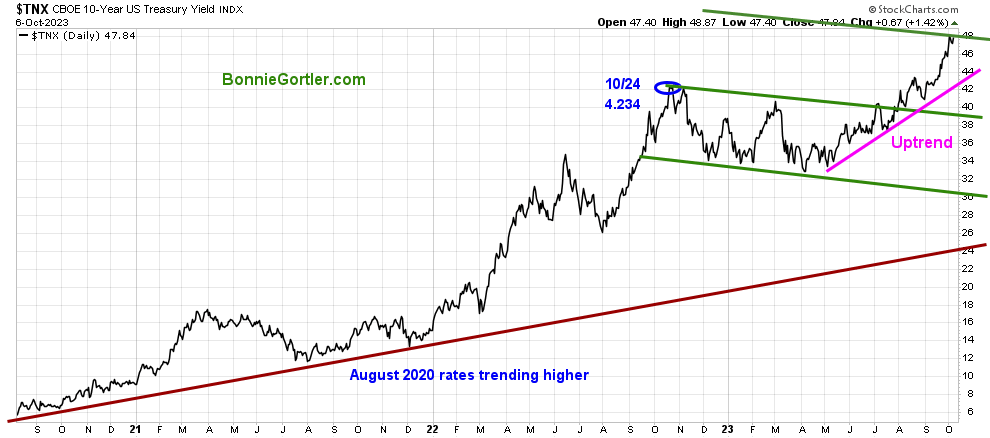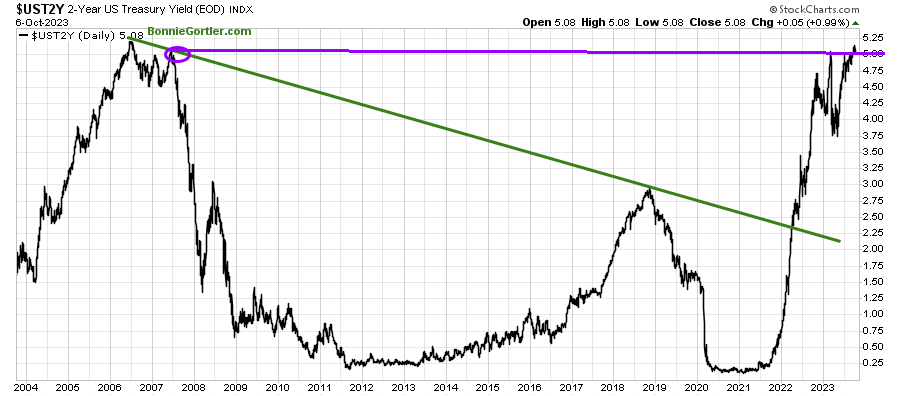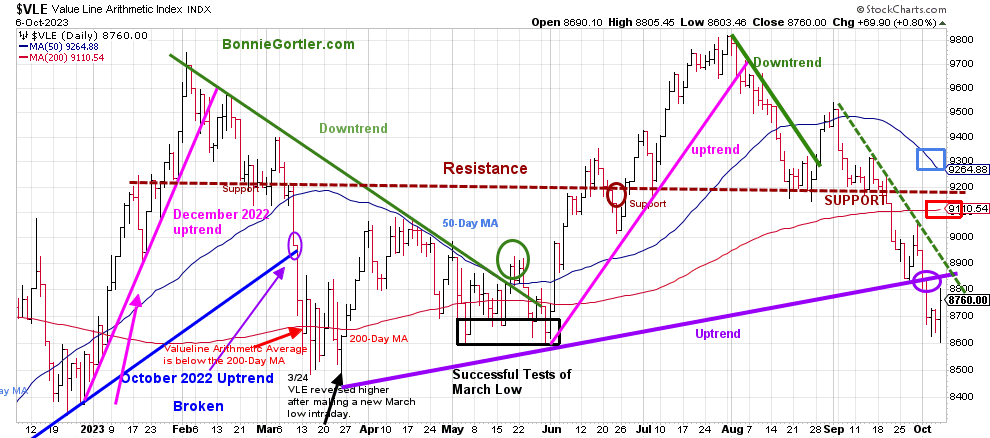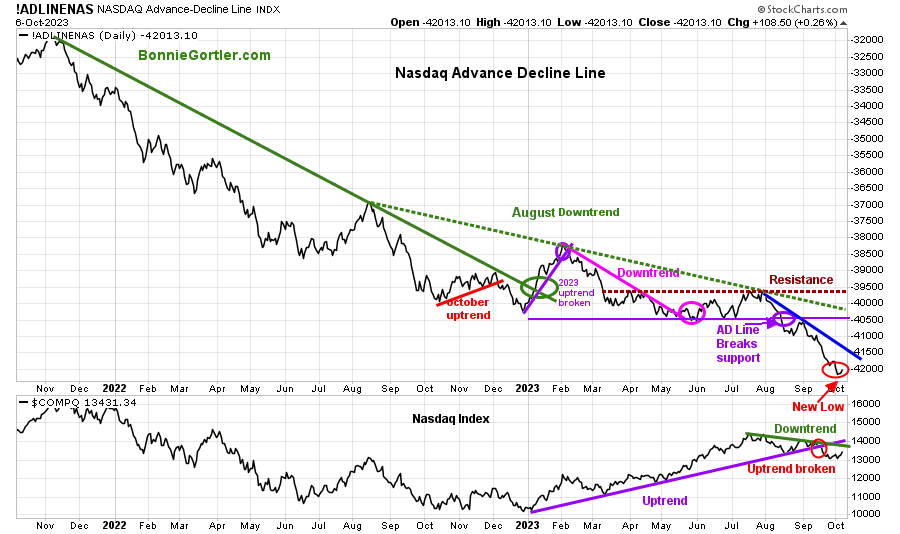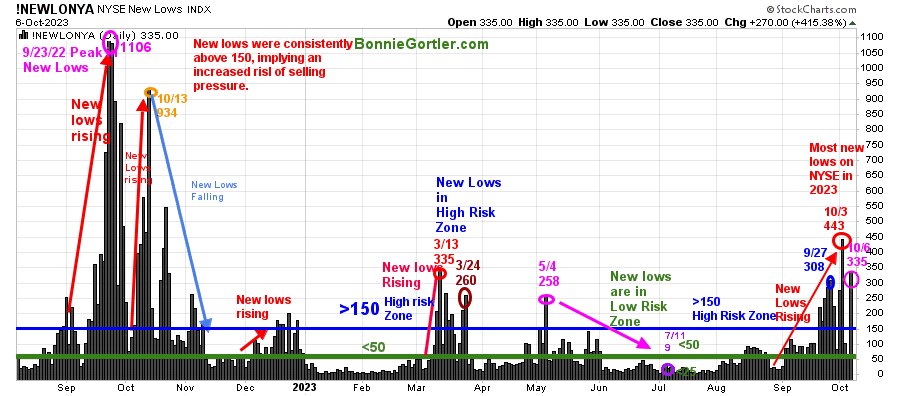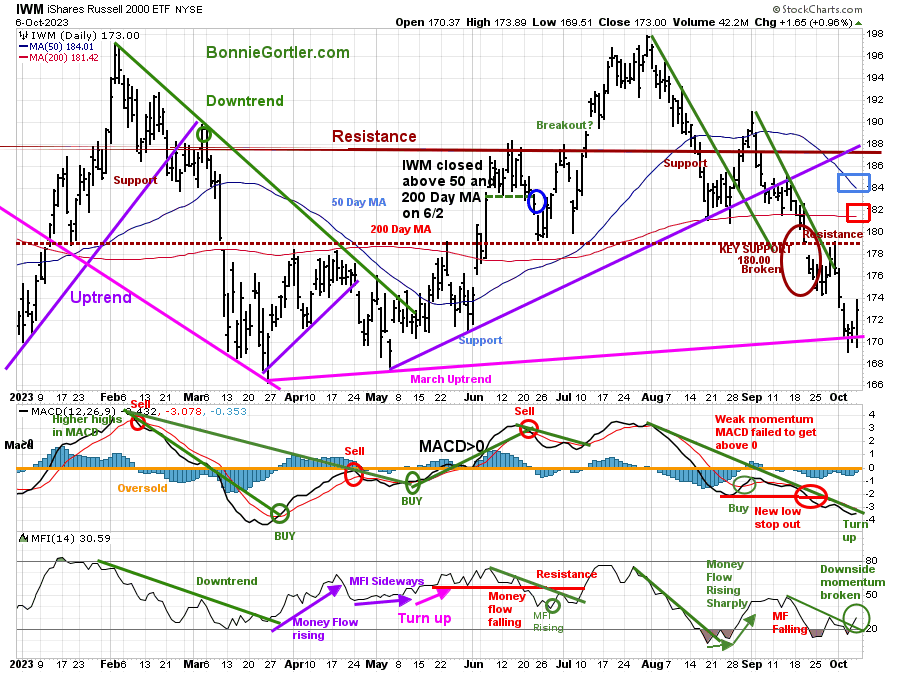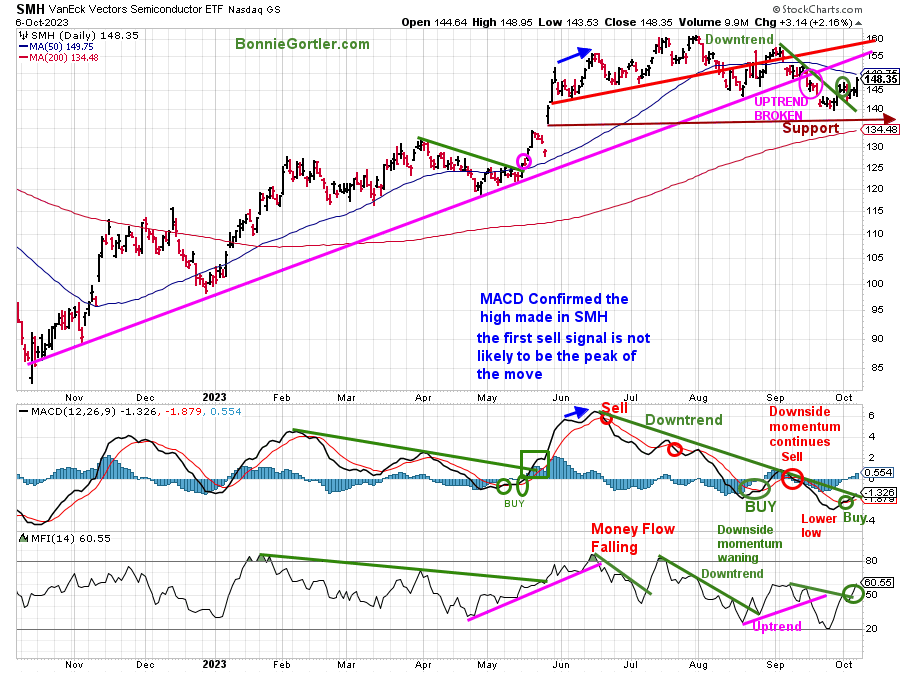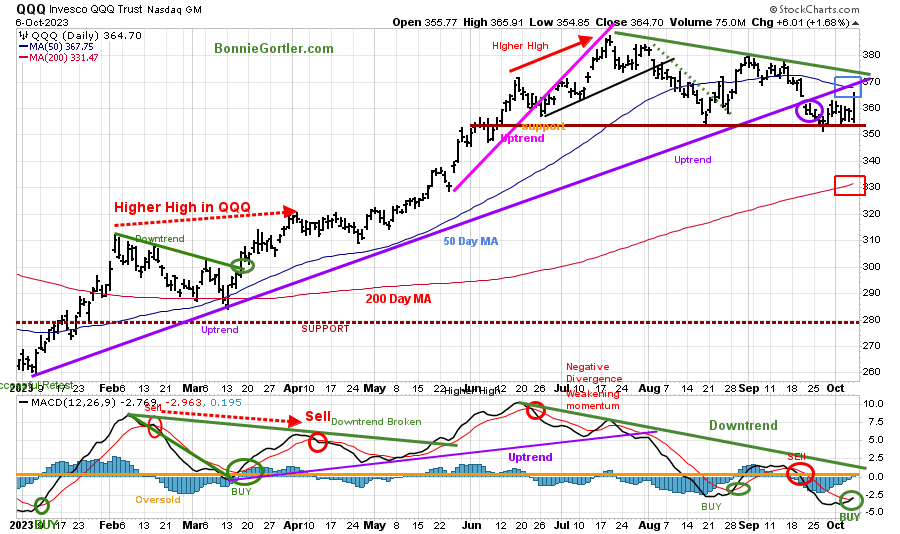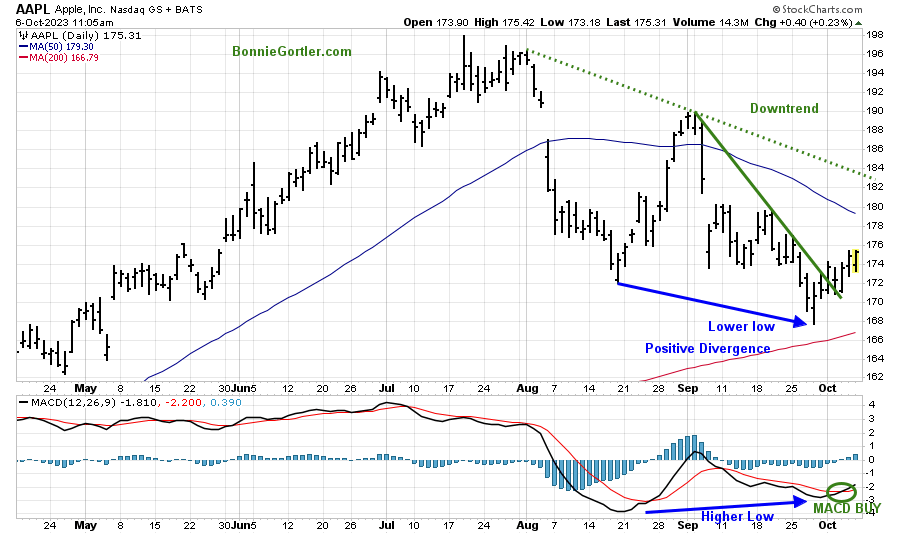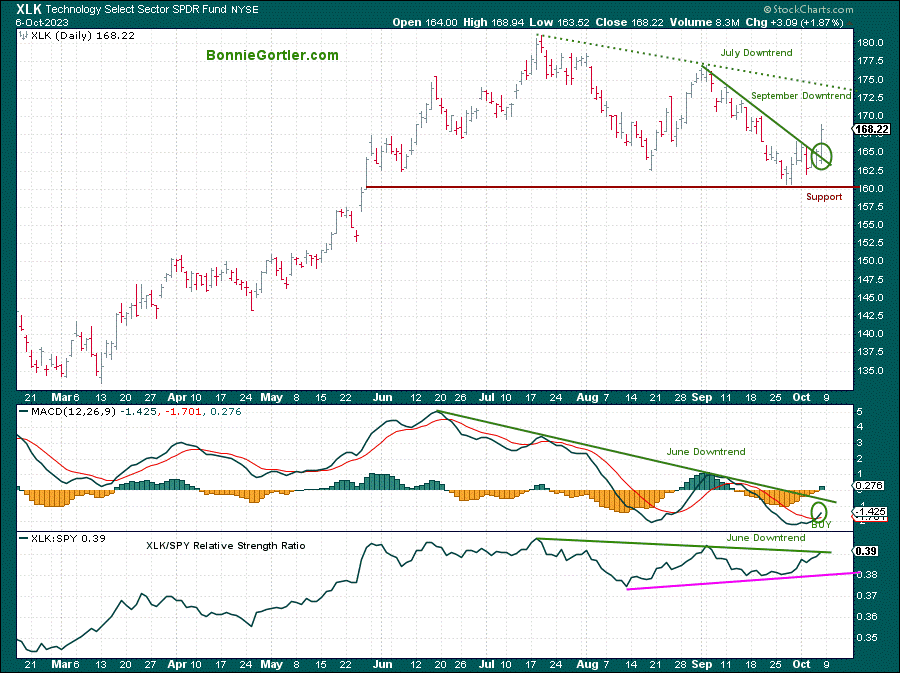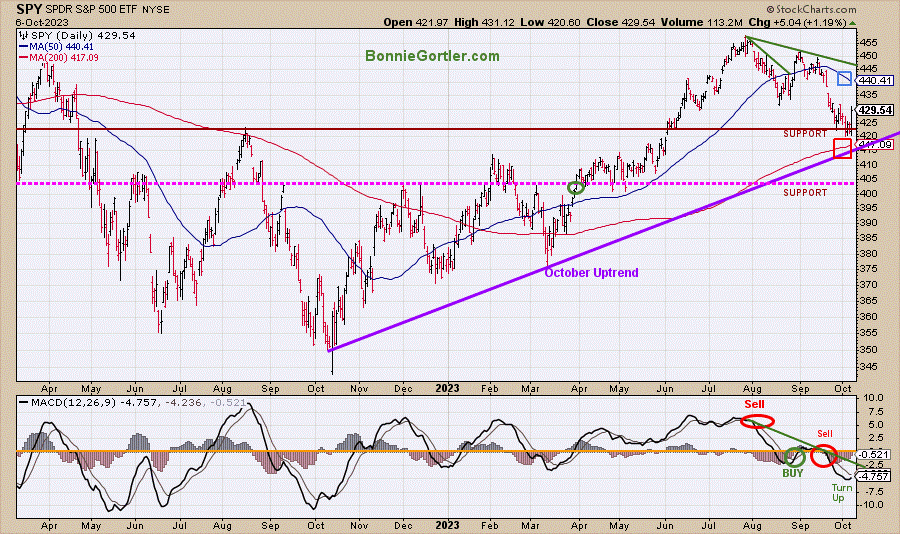After the jobs report’s release on Friday, there was initial selling by investors, followed by the buyers stepping in. For the week, three S&P SPDR sectors finished higher. Technology (XLK) and Communication Services (XLC) were the best sectors, while Consumer Staples (XLP) and Energy (XLE) were the weakest. The SPDR S&P 500 ETF Trust (SPY) up +0.48%.
S&P SPDR Sector ETFs Performance Summary 9/29/23-10/6/23
Source: Stockcharts.com
Figure 2: Bonnie’s ETFs Watch List Performance Summary 9/29/23-10/6/23
Source: Stockcharts.com
Semiconductors and Technology showed strength while Small Cap Value and Growth lagged, continuing to underperform.
Where do we go from here?
Figure 3: CBOE Volatility Index VIX
Source: Stockcharts.com
The CBOE Volatility Index (VIX), a measure of fear, traded above 20.00 for most of 2022, with a high at 36.95 on 3/7 (blue circle). A new VIX low did not occur until 1/13/23 at 18.35 (green circle) after peaking in October 2022 at 33.63 (red circle).
When the week was complete, VIX fell slightly, closing at 17.45 (purple circle), finishing below the week’s high of 19.78 on 10/3 and the 8/19 high at 17.89 (red circle).
VIX continuing to fall will imply Friday’s rally will continue, with less risk of a short-term decline. However, be alert to wider daily intraday swings and increased risk if VIX rises and closes above 20.00.
Short and longer-term yields continue to trend higher.
Figure 4: UST 10YR Bond Yields Daily
Source: Stockcharts.com
The 10-year U.S. Treasury yields continued higher, hitting the top channel, closing at 4.784%, and remaining in the May uptrend (pink line).
Figure 5: UST 2YR Bond Yields Daily
Source: Stockcharts.com
The 2-year U.S. Treasury yields closed at 5.08%, levels not seen since 2007 (purple circle).
Yields, whether short or long, accelerating higher is likely to result in continued pressure on equities. However, if rates stabilize and turn down, selling pressure in equities will likely ease.
Last week, the major market averages closed higher, thanks to Friday’s upside reversal, but the broader market averages finished the week lower. The Dow gained +0.79%, the S&P 500 gained +0.48%, Nasdaq +1.60%, the strongest average, while the Russell 2000 Index fell -2.22%.
Figure 6: Value Line Arithmetic Average
Source: Stockcharts.com
The Value Line Arithmetic Index ($VLE) is a mix of approximately 1700 stocks. VLE broke the October 2022 uptrend in early March (blue line), and April, May, and June successfully tested the March low.
The downtrend continued last week. VLE closed down -2.13%, breaking the March uptrend and shifting the daily trend to down (purple line), remaining below the 200-day MA (red rectangle) and 50-day MA (blue rectangle).
VLE closed at 8760, below support at 8800, now acting as resistance. The next resistance is at 9100 and 9300. Support is 8600 and 8400.
Until there are two closes above the September downtrend (green dotted line), any rise is suspect and will likely be only a relief rally followed by another test of the March low before a more favorable bottom formation occurs.
Do you want to go deeper into charting? Learn more in the comfort of your home today with my Free 33-minute Training, Charting Strategies to Cut Risk and Trade with the Trend. Sign up here.
Market breadth remains troublesome.
Weekly market breadth was negative on the New York Stock Exchange Index (NYSE) and for the Nasdaq. The NYSE had 755 advances and 2275 declines, with 55 new highs and 642 new lows. There were 1661 advances and 3094 declines on the Nasdaq, with 95 new highs and 962 new lows.
Market breadth remains concerning, with more stocks making weekly New Lows and fewer stocks making weekly New Highs on the NYSE and Nasdaq. Breadth needs to improve for a broad rally to be sustainable.
If you want to go more in-depth with charts, I invite you to join my FB group, Wealth Through Market Charts.
Figure 7: Nasdaq Advance Decline Line Daily (Top) and Nasdaq (Bottom)
Source: Stockcharts.com
The top chart is the Nasdaq Daily Advance-Decline Line, a technical indicator that plots the difference between the number of advancing and declining stocks. In January 2023, the October 2022 downtrend was broken (solid green line) but quickly reversed lower in February 2023, when most of the stock participation was the large Mega Cap Stocks.
The AD-Line (top chart) broke support (purple circle) in August and remains weak, continuing to make new lows in 2023. It remains negative that breadth remains below old support (purple line) and in a downtrend from August 2022 (green dotted line) and the July 2023 downtrend (blue line).
The Nasdaq (lower chart) rose last week but remained in a downtrend from July. Without consistent positive market breadth and better tape action, more time is needed for a major bottom.
Figure 8: Daily New York Stock Exchange (NYSE) New Lows
Source: Stockcharts.com
Watching New Lows on the New York Stock Exchange is a simple technical tool that helps awareness of the immediate trend’s direction. New lows warned of a potential sharp pullback, high volatility, and “panic selling” for most of 2022, closing above 150. The peak reading was 9/23/22 when New Lows made a new high of 1106 (pink circle), and New Lows expanded to their highest level in 2023 on 3/13/23 (red circle) to 335.
New Lows have risen since September (red arrow on the right) toward the high-risk zone greater than 150. On 10/3, New Lows peaked at 443, the highest reading since October 2022.
New lows closed at 335 on 10/6 (pink circle) despite Friday’s upside reversal remaining in a high-risk zone.
It will be favorable if the New Lows fall below 150 for two consecutive days and then contract towards 50, ultimately closing below 25 (the lowest risk zone). On the other hand, if New Lows remain above 150, it will imply an increased risk of further downside.
Learn more about the significance of New Lows in my book, Journey to Wealth, published on Amazon. If you would like a preview, get a free chapter here.
Figure 9: Daily iShares Russell 2000 (IWM) Price (Top) and 12-26-9 MACD (Middle and Money Flow (Bottom)
Source: Stockcharts.com
The top chart is the daily iShares Russell 2000 Index ETF (IWM), the benchmark for small-cap stocks, with a 50-Day Moving Average (MA) (blue line) and 200-Day Moving Average (MA) (red line) that traders watch and use to define trends.
IWM closed up 0.96% on Friday but finished down -2.12% for the week, closing at 173.00, remaining below the 200-day MA (blue rectangle) and the 50-day MA.
Support is at 170.00. Resistance is at 174.00, 180.00,184.00, and 188.00.
MACD (middle chart) is on a sell after making a lower low but is now rising and close to generating a buy signal, combined with a break of downside momentum (green line), which would be short-term bullish.
Money Flow (lower chart) is now rising after reaching an oversold condition below 20 and breaking the downtrend since September, implying money is beginning to flow into Small Caps.
Semiconductors leadership is bullish.
Figure 10: Daily Semiconductors (SMH) (Top) and 12-26-9 MACD (Middle and Money Flow (Bottom)
Source: Stockcharts.com
The top chart shows the Daily Semiconductors (SMH) ETF, concentrated mainly in US-based Mega-Cap Semiconductors companies. SMH tends to be a lead indicator for the market when investors are willing to take on increased risk and the opposite when the market is falling.
Semiconductors (SMH) gained +2.32% last week for back-to-back positive gains, leading the market higher.
Support is at 143.00, 140.00 and 133.00. Resistance is at 151.00 and 160.00.
SMH still has work to do because SMH remains below the 2022 October uptrend (pink line), where the uptrend in October broke down before turning up after holding above support (brown line).
MACD (middle chart) generated a buy last week, and it would be positive if the downside trendline (green line) from June breaks.
Money Flow (lower chart) broke the September downtrend (green line), confirming the MACD buy, which is a plus and implies buyer interest in Semiconductors.
In Sum:
It’s positive SMH turned up for the second week and showed improving relative strength vs. QQQ. Time will tell if the rally is only a relief rally that may be temporary if the rally stalls. On the other hand, a close above 151.00 followed by above 160.00 would likely cause the bears to close their shorts, indicating more gains to follow.
Technology showing leadership
Figure 11: Daily Invesco QQQ Trust (QQQ) Price (Top) and 12-26-9 MACD (Bottom)
Source: Stockcharts.com
The chart shows the daily Invesco QQQ, an exchange-traded fund based on the Nasdaq 100 Index. QQQ made a low in October 2022 (red circle), followed by a successful retest of the low in early January 2023 and the start of an uptrend.
QQQ broke its 2023 uptrend (purple circle) after a few attempts at the July high.
Last week, QQQ gained +1.79%, holding support at 355.00, closing at 364.90, remaining below the 50-day Moving Average (blue rectangle) and above the 200-day Moving Average (red rectangle), which is positive.
Support is 355.00, 350.00, and 335.00, with resistance at 365.00, 375.00, and 380.00.
The bottom chart is MACD (12, 26, 9) generated a buy but remains in the momentum downtrend from June 2023.
Continued leadership by Apple (AAPL) could ignite the broad market higher.
Figure 12: Apple (AAPL) Price (Top) and 12-26-9 MACD (Bottom)
Apple (AAPL), the largest holding in QQQ, broke its September downtrend (green line), shifting the daily trend to up. Its positive AAPL has formed a positive divergence, one of my favorite patterns, a lower low in price and a higher low in momentum.
Support is at 173.00, 170.00, and 166.00. Resistance is 180.00, 185.00, and 195.00.
MACD, a measure of momentum (bottom chart), generated a buy last week.
Keep an eye on AAPL for leadership next week, starting with a close above the 50-day moving average at 179.34.
Figure 13: Technology Select SPDR (XLK) Price (Top) and 12-26-9 MACD (Middle) and Technology SPDR/S&P 500 XLK/SPY Relative Strength Ratio
Source: StateStreet – SSGA
XLK: The Technology Select Sector Index represents the technology sector of the S&P 500 Index. The Index includes companies from the following industries: technology hardware, storage, and peripherals; software; communications equipment; semiconductors and semiconductor equipment; IT services; and electronic equipment, instruments, and components. The top holdings as of October 5th are Apple and Microsoft, totaling 46.57%.
It’s bullish for Technology stocks that XLK broke the September downtrend last week and generated a Daily MACD Buy.
Watch if the June downtrend in momentum (middle chart) and the relative strength ratio (lower chart) break this week, which would confirm further upside.
Figure 14: The S&P 500 Index (SPY) Daily (Top) and 12-26-9 MACD (Bottom)
Source: Stockcharts.com
The S&P 500 (SPY) uptrend remains since October 2022 (purple line).
The SPY closed well, avoiding a five-week losing streak up +0.48%, closing at 429.54, remaining below the falling 50-day Moving Average (blue rectangle) but above the 200-day Moving Average (red rectangle), which acted as support last week.
Resistance is 435.00, 446.00, and 452.00. Support is at 425.00, 415.00, and 405.00.
MACD (bottom chart) is on a sell but rising and close to generating a buy.
If the SPY can hold above Friday’s low at 420.50 and Technology stocks move higher, another rally toward 435.00 is likely.
Summing Up:
The major averages stabilized Friday, with Semiconductors and Technology stocks leading and breaking their daily downtrends. Short-term momentum oscillators are oversold and have begun to turn up as downside momentum has slowed and is in a position where potential buying opportunities develop. If Small and Mid-Cap stocks can join Semiconductors and Technology stocks and there is an improvement in market breadth, then there is a good chance the decline is over and a fourth-quarter rally has begun.
Remember to manage your risk, and your wealth will grow.
Let’s talk investing. You are invited to set up your Free 30-minute Wealth and Well-Being Strategy session by clicking here or emailing me at Bonnie@BonnieGortler.com. I would love to schedule a call and connect with you.
Disclaimer: Although the information is made with a sincere effort for accuracy, it is not guaranteed that the information provided is a statement of fact. Nor can we guarantee the results of following any of the recommendations made herein. Readers are encouraged to meet with their own advisors to consider the suitability of investments for their own particular situations and for determination of their own risk levels. Past performance does not guarantee any future results.



